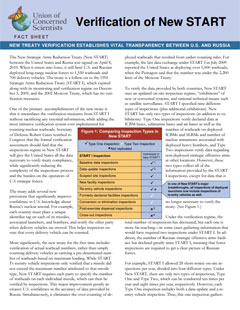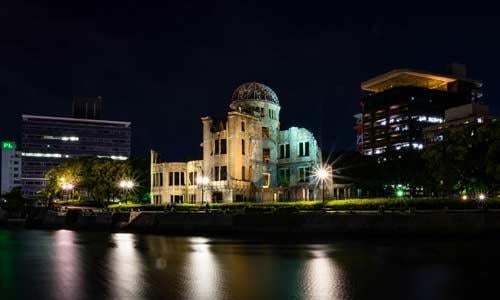The New Strategic Arms Reduction Treaty (New START) between the United States and Russia was signed on April 8, 2010. When it enters into force, it will limit U.S. and Russian deployed long-range nuclear forces to 1,550 warheads and 700 delivery vehicles. The treaty is a follow-on to the 1991 Strategic Arms Reduction Treaty (START I), which expired along with its monitoring and verification regime on December 5, 2009, and the 2002 Moscow Treaty, which has no verification measures.
One of the primary accomplishments of the new treaty is that it streamlines the verification measures from START I without sacrificing any essential information, while adding the most intrusive verification system ever implemented for counting nuclear warheads. Secretary of Defense Robert Gates testified to Congress that the formal verification assessment should find that the inspections regime in New START will give the United States all the data necessary to verify treaty compliance, while significantly reducing the complexity of the inspections process and the burden on the operators of U.S strategic forces.
The treaty adds several new provisions that significantly improve confidence in U.S. knowledge about Russia’s nuclear arsenal. For example, each country must place a unique identifier tag on each of its missiles, associated launchers, and bombers, and notify the other party when delivery vehicles are moved. This helps inspectors ensure that every delivery vehicle can be counted.
More significantly, the new treaty for the first time includes verification of actual warhead numbers, rather than simply counting delivery vehicles as carrying a pre-determined number of warheads based on maximum loading. While START I’s reentry vehicle inspections only verified that a missile did not exceed the maximum number attributed to that missile type, New START requires each party to specify the number of warheads on each individual missile, which can then be verified by inspections. This major improvement greatly in-creases U.S. confidence in the accuracy of data provided by Russia. Simultaneously, it eliminates the over-counting of deployed warheads that resulted from earlier counting rules. For example, the last data exchange under START I in July 2009 reported the United States as deploying over 5,900 warheads, when the Pentagon said that the number was under the 2,200 limit of the Moscow Treaty.
To verify the data provided by both countries, New START uses an updated on-site inspection regime, “exhibitions” of new or converted systems, and national technical means such as satellite surveillance. START I specified nine different types of inspections (plus additional exhibitions). New START has only two types of inspections (in addition to exhibitions): Type One inspections verify declared data at ICBM bases, submarine bases and air bases as well as the number of warheads on deployed ICBMs and SLBMs and number of nuclear armaments associated with deployed heavy bombers, and Type Two inspections verify data regarding non-deployed strategic offensive arms at other locations. However, these two types collect all of the information provided by the START I inspections, except for data that is no longer necessary to verify the treaty.
Under the verification regime, the total number of inspections has decreased, but each one is more far-reaching—in some cases gathering information that would have required two inspections under START I. In addition, the number of Russian strategic offensive arms facilities has declined greatly since START I, meaning that fewer inspections are required to get a clear picture of Russian forces.
For example, START I allowed 28 short-notice on-site in-spections per year, divided into four different types. Under New START, there are only two types of inspections, Type One and Type Two, which can be conducted ten times per year and eight times per year, respectively. However, each Type One inspection includes both a data-update and a re-entry vehicle inspection. Thus, this one inspection gathers information that would have required two separate START I inspections to collect, as illustrated in Figure 2.1. As a result, the amount of inspection activity is less but the outcome is identical—and thus more efficient—under New START.
The continued strength of the New START inspections is also apparent when one accounts for the reduced number of Russian facilities. START I had more inspections, but U.S. inspectors had over twice as many facilities to check. Thanks to cooperative efforts since the breakup of the Soviet Union, many facilities previously associated with strategic offensive arms have been closed. Inspectors under New START will only be concerned with 35 Russian facilities, compared to around 70 under START I, including sites in other countries of the former Soviet Union that were party to that treaty. As a result, New START allows the United States to inspect a greater percentage of Russian facilities every year as under START I.
New START includes some changes to the verification of mobile missiles. First, the post-dispersal inspection of mobile missiles has been eliminated. However, mobile missiles are still tracked using their unique identifiers and inspected at missile bases in the same manner as other systems. Second, there is no longer continuous monitoring of Russia's mobile missile production plant at Votkinsk, as there was under START I. The Bush administration agreed to end such monitoring and Russia rebuffed U.S. efforts to restore it under New START. Instead, Russia must notify the United States 48 hours before any missile leaves the plant, allowing U.S. national technical means of verification to come to bear. Together with data exchanged on the location and movement of systems, the unique identifiers described above, and periodic on-site inspections at missile bases, the regime will allow the United States to track the numbers of Russia’s mobile missile forces and detect any militarily significant breach of the treaty.
Telemetry exchange is also different between START I and New START. Verification of START 1 relied heavily on ex-change of telemetry—the technical data that a missile sends back about its operation during a flight test. Verifying START I required this data since the treaty did not directly verify how many warheads a missile carried, but counted each type of missile as carrying the maximum number of warheads it had carried in tests; this number was determined in part by telemetry. Telemetry was also used to verify that tests were not being used to develop new types of missiles that were banned under the treaty. Since New START counts actual warheads and does not contain limits on new missile types, telemetry is not needed for verification, and the limited telemetry exchanges are an extra, confidence-building measure between the two countries.
In sum, the United States will be able to verify Russian compliance with New START with equal confidence than under START I. All necessary data will be gathered in a more streamlined fashion, sparing time and resources. Inspectors will make fewer but more comprehensive inspections, and will be able to inspect a greater percentage of Russian facili-ties per year than previously.
- Specific baseline inspections will not occur because the U.S already has baseline data on Russian facilities from START I inspections taking place from 1994-2009.
- There is no longer a list of suspect sites to inspect, as there was under START I (which specified three sites for each party). Instead, all sites are treated the same under either a Type One or Type Two inspection.
- New START removes provisions specific to mobile ICBMs, including this inspection. However, mobile ICBMs must be located at missile bases, and inspectors will be able to verify their presence there.
- Specific close-out inspections no longer exist, because fewer facilities are being closed. However, previously closed facilities can be inspected under Type Two inspections
- New START allows for 10 Type One inspections, but since each one gathers information that required two inspections under START I, they can be doubled for the purpose of comparison, making the number of inspections under New START effectively the same as under START I.
- Under START I, this included facilities in Kazakhstan, Belarus, and Ukraine, which contained former Soviet bases that were subject to inspection.




